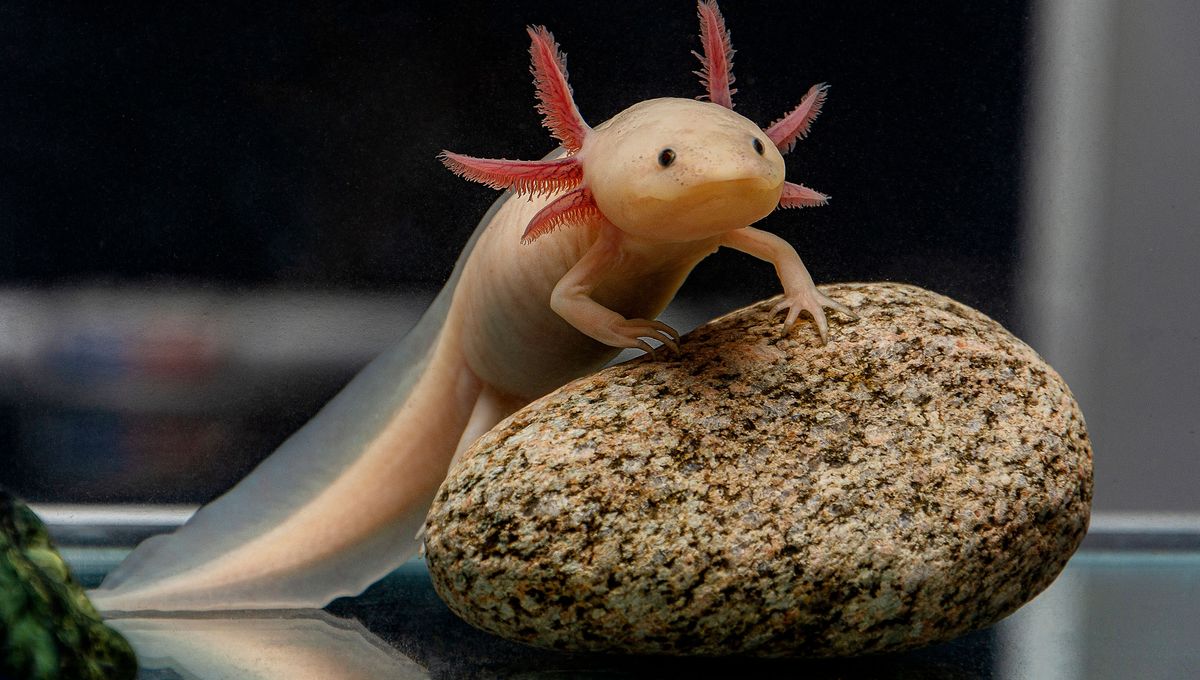
Human beings generally have pretty lousy hearing, so it’s unsurprising to learn that there are a lot of animals we weren’t aware are actually talking behind our backs. At the same time, our penchant for anthropomorphizing often has us thinking animals are trying to communicate when really they’re not. For the purpose of this article, we’ll be considering the ability to “talk” in relation to the possession of any vocal organs.
Back to the anthropomorphizing, here are some animals that may or may not be trying to talk.
Can axolotls talk?
No, axolotls can’t talk. Despite the popularity of videos showing these quirky amphibians appearing to bark, axolotls don’t actually have any vocal cords. That doesn’t seem to stop them though – they can instead create noises through muscle contractions and by gulping air from the surface of the water. This results in sounds like barking, hiccuping, and squeaking.
Axolotls can breathe in four different ways: while they predominantly use their gills, they can also breathe through their lungs, by using a buccopharyngeal membrane at the back of their mouth, and through their skin. However, only breathing through their lungs creates this gulping sound, which makes it relatively rare to hear.
These axolotl sounds are completely involuntary and not used as a tool for communication. These solitary creatures are completely deaf, they don’t use mating calls, or any helping calls to communicate. Along with their lack of ears, axolotls’ eyesight is also very poor, instead they rely on vibrations in the water to sense the world around them.
Can lizards talk?
Yes, some species of lizard can “talk”. While many lizard species are able to hiss, not all of them posses the gift of the gab. Of the over 7,000 lizard species world-wide, geckos are the only genus with true vocal cords, and boy do they like to shout about it.
One of the noisiest of all gecko species is the New Caledonian giant gecko (Rhacodactylus leachianus), or more adorably, leachie. Growing to around 35.5 centimeters (14 inches) and weighing up to 340 grams (12 ounces), leachies are the largest known gecko species.
These giant lizards are nocturnal and known for making loud growls, squeaks, and yips throughout the night, earning themselves the nickname “the devil in the trees”. Along with other species of geckos, leachies’ vocalizations are used in mating behavior, to ward off potential predators, and to protect their territory.
Can snakes talk?
Largely, no, most species of snakes don’t have vocal organs, but a very select few have a specialized mechanism similar to the vocal cords of more chatty animals. The bull snake and pine snake are in the genus Pituophis, in the Colubridae family of non-venomous snakes endemic to North America. Snakes in this genus can make a loud bellowing sound thanks to a unique anatomical feature that no other known animal has.
While the snakes sound is largely produced by the exhalation of air, the addition of a simplified vocal cord allows them to create this iconic bellow. Humans and other chatty species have vocal cords arranged in pairs vertically, but the Pituophis snakes have one single cord arranged horizontally across the top of the larynx.
Along with their modified vocal cord, these snakes also have a piece of tissue called an epiglottal keel. This hard piece of cartilage bisects the windpipe and diverts the expulsion of air into two pathways. By narrowing the tunnels that the air passes through, the sound becomes louder, adding extra volume to their bellow.
Despite there being over 3,000 species of snakes with no vocal organs, and given that they are completely deaf with no ears, snakes are surprisingly communicative – even if it is just trying to make us leave them alone. The iconic rattle is used by over 24 different species of rattlesnake, and it’s a clever and complex tool that produces a loud and threatening buzz.
Despite sounding like their tails are full of beads like tiny maracas, the sound is actually produced by hard rings of keratin at the base of the tail hitting against one another as the snake shakes its tail up to 90 times a second. Each time the snake sheds it adds a single rattle to the end of its tail, increasing the sound projection.
A study into the rattlesnake’s use of this clever appendage have shown they are able to manipulate frequencies to trick humans into thinking they are closer than they are. Observing western diamondback rattlesnakes, the researchers noticed a slower rattle of 40 hertz when the threat was further away, but as they got closer the frequency increased to between 60 and 100 hertz, tricking the observer into thinking the snake was actually much closer.
Can shrimp talk?
No, shrimp can’t talk, but they do communicate using sound. Rather unsurprisingly, they don’t posses any vocal organs in their tiny bodies – but they can snap their claws and create small imploding air bubbles in the water. These snapping shrimp, of which there are over 300 species, are said to be some of the loudest coral reef lifeforms. Their frantic snapping sounds like frying bacon and are used to communicate within their colonies.
More impressive still, Synalpheus pinkfloydi, named after the band Pink Floyd, is a tiny crustacean with a flamboyantly pink claw which it uses to stun its prey. The sound produced from its bright pink boombox is one of the loudest sounds in the ocean. It snaps at such a speed that the bubble produced creates a sonic blast when it collapses, reaching 210 decibels – louder than a gun shot.
The blast produced is enough to stun and even kill its prey, and for a split second the bubble generates temperatures of 4,400°C (7,950°F), which is almost as hot as the surface of the sun. Very rock and roll.
Source Link: Do Axolotls Make Noise? And Other Not-So-Silent Animals